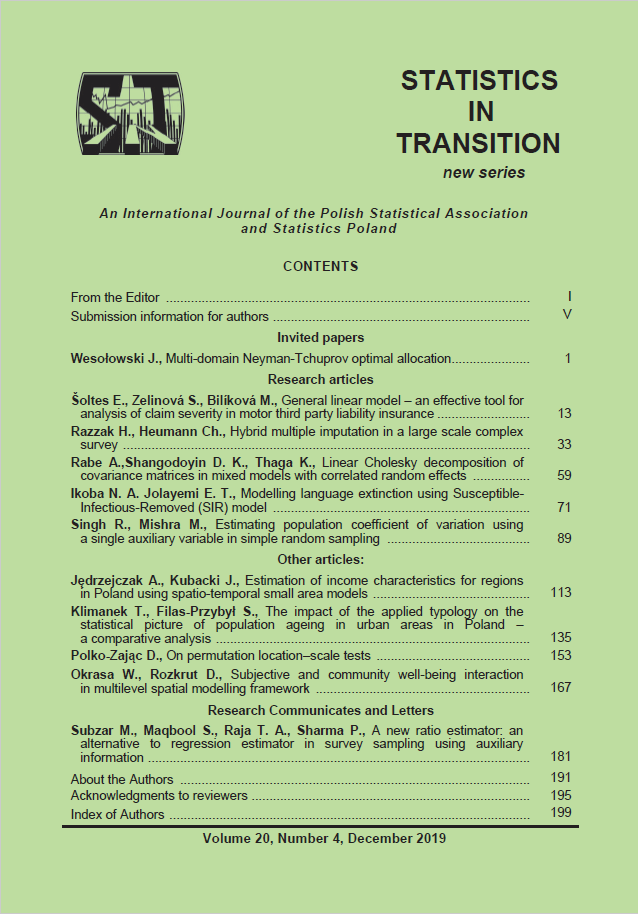ARTICLE - the electronic version of the article differs from the paper version
ABSTRACT
The eigenproblem solution of the multi-domain efficient allocation is identified as a direct generalization of the classical Neyman-Tchuprov optimal allocation in stratified SRSWOR. This is achieved through analysis of eigenvalues and eigenvectors of a suitable population-based matrix D. Such a solution is an analytical companion to NLP approaches, which are often used in applications, see, e.g. Choudhry, Rao and Hidiroglou (2012). In this paper we are interested rather in the structure of the optimal allocation vector and relative variance than in such purely numerical tools (although the eigenproblem solution provides also numerical solutions, see, e.g. Wesołowski and Wieczorkowski (2017)). The domain-wise optimal allocation and the respective optimal variance of the estimator are determined by the unique direction (defined in terms of the positive eigenvector of matrix D) in the space I , where I is the number of domains in the population.
KEYWORDS
Neyman-Tchuprov allocation, multi-domain allocation, eigenproblem, stratified SRSWOR
REFERENCES
CHOUDHRY, G. H., RAO, J. N. K., HIDIROGLOU, M. A., (2012).On sample allocation for efficient domain estimation, Survey Meth. 38(1) , pp. 23–29.
FRIEDRICH, U., MUNNICH, R., DE VRIES, S., WAGNER, M., (2015). Fast integervalued algorithm for optimal allocations under constraints in stratified sampling, Comp. Statist. Data Anal., 92 , pp. 1–12.
FRIEDRICH, U., MUNNICH, R., RUPP, M., (2018). Multivariate optimal allocation with box-constraints, Austrian J. Statist., 47 , pp. 33–52.
GABLER, S., GANNINGER, M., M¨UNNICH, R., (2012). Optimal allocation of the sample size to strata under box constraints, Metrika, 75(2) , pp. 151–161.
KATO, T., (1981), A Short Introduction to Perturbation Theory for Linear Operators, Springer, New York.
KHAN, M. G. M., WESOŁOWSKI, J., (2019). Neyman-type sample allocation for domains-efficient estimation in multistage sampling. Adv. Stat. Anal., 103 , pp. 563–592.
KOZAK, M., (2004). Method of multivariate sample allocation in agricultural surveys. Biom. Collq., 34 , pp. 241–250.
KOZAK, M., ZIELI ´NSKI, A., (2005). Sample allocation between domains and strata. Int. J. Appl. Math. Stat, 3 , pp. 19–40.
KOZAK, M., ZIELI ´NSKI, A., SINGH, S., (2008). Stratified two-stage sampling in domains: sample allocation between domains, strata and sample stages. Statist. Probab. Lett., 78 , pp. 970–974.
LONGFORD, N. T., (2006). Sample size calculation for small-area estimation. Survey Meth., 32 , pp. 87–96.
NIEMIRO, W., WESOŁOWSKI, J., (2001). Fixed precision allocation in two-stage sampling. Appl. Math., 28 , pp. 73–82.
SARNDAL, C.-E., SWENSSON, B., WRETMAN, J., (1992). Model Assisted Survey Sampling, Springer, New York .
VALLIANT, R., DEVER, J.A., KREUTER, F., (2013). Practical Tools for Designing and Weighting Sample Surveys, Springer.
WESOŁOWSKI, J., WIECZORKOWSKI, R., (2017). An eigenproblem approach to optimal equal-precision sample allocation in subpopulations. Comm. Statist. Theory Meth., 46(5) , pp. 2212–2231.
WRIGHT, T., 2017). Exact optimal sample allocation: More efficient than Neyman. Statist. Probab. Lett., 129 (, pp. 50–57.
